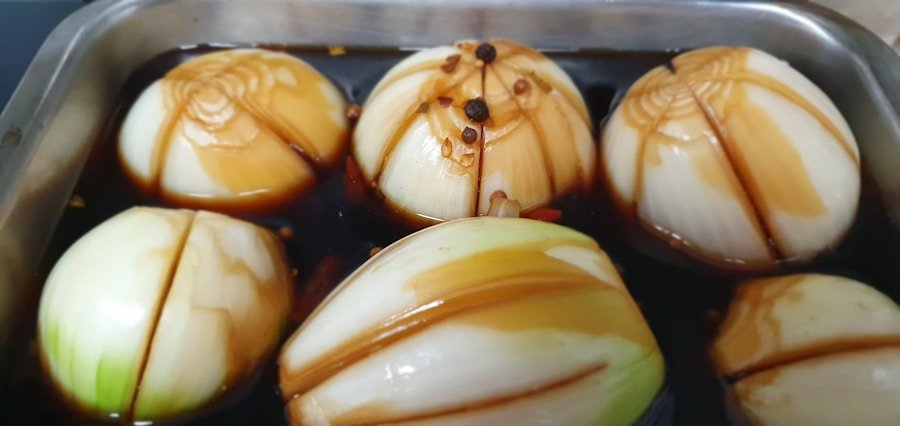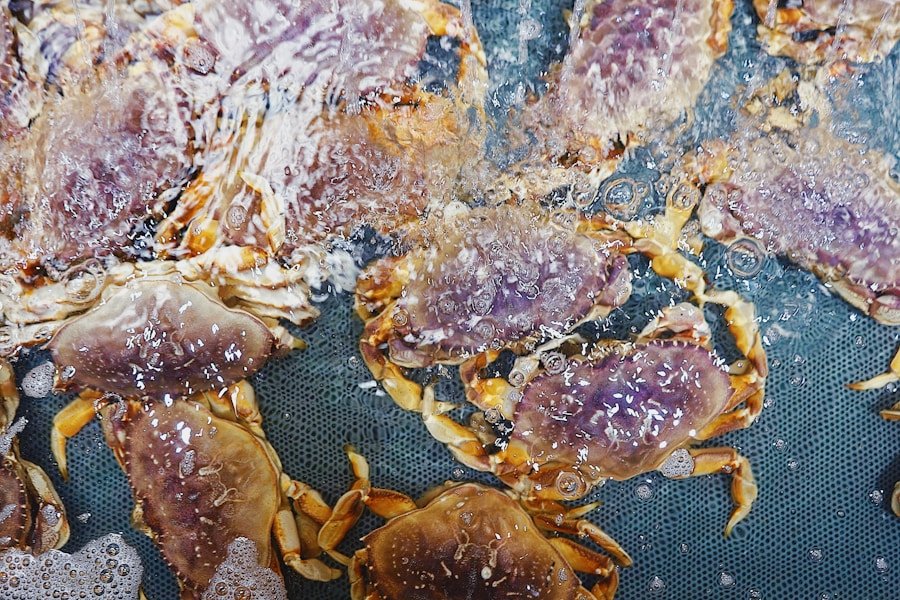Caramelizing onions is a culinary technique that transforms the sharp, pungent flavor of raw onions into a sweet, rich, and complex taste through a slow cooking process. This method relies on the Maillard reaction and the breakdown of sugars present in the onions, which occurs when they are exposed to heat over time. The process not only alters the flavor profile but also changes the texture, resulting in soft, golden-brown strands that can elevate a variety of dishes.
The key to successful caramelization lies in patience; rushing the process can lead to burnt onions rather than the desired sweet, nutty flavor. The process begins with the breakdown of the onion’s natural sugars, which caramelize as they cook. This transformation is not instantaneous; it requires a gentle heat and time to allow the sugars to develop fully.
Typically, caramelizing onions can take anywhere from 20 to 45 minutes, depending on the quantity and the heat level used. The result is a deeply flavored ingredient that can be used in soups, sauces, sandwiches, and numerous other dishes, adding depth and richness that is hard to replicate with other ingredients.
Key Takeaways
- Caramelizing onions involves cooking them low and slow until they become sweet and golden brown.
- Use yellow or red onions for caramelization as they have a higher sugar content and better flavor.
- Slice onions thinly and cook them in a combination of oil and butter for the best caramelization results.
- Stir the onions occasionally and adjust the heat to prevent burning and ensure even caramelization.
- Add flavor enhancements such as balsamic vinegar, brown sugar, or fresh herbs to elevate the taste of caramelized onions.
Choosing the Right Onions for Caramelization
When it comes to selecting onions for caramelization, not all varieties are created equal. The most commonly used types are yellow onions, which are known for their balanced flavor profile that combines sweetness and sharpness. Yellow onions contain a higher sugar content compared to white or red onions, making them ideal for achieving that coveted caramelized flavor.
Their natural sugars caramelize beautifully when cooked slowly, resulting in a rich, golden-brown color and a sweet taste. Red onions can also be used for caramelization, though they tend to have a milder flavor and a slightly different sweetness profile. They often retain a bit of their sharpness even after cooking, which can add an interesting contrast in certain dishes.
White onions, on the other hand, are less commonly used for caramelizing due to their higher water content and lower sugar levels. While they can still be caramelized, they may not yield the same depth of flavor as yellow or red onions. Ultimately, the choice of onion can significantly influence the final taste of your dish, so selecting the right variety is crucial for achieving optimal results.
Preparing Onions for Caramelization

Preparation is key when it comes to caramelizing onions effectively. Start by peeling off the outer skin of the onion and trimming both ends. The next step involves slicing the onion uniformly to ensure even cooking.
A common method is to cut the onion in half from root to tip and then slice it into thin half-moons or rings. The thickness of these slices can affect cooking time; thinner slices will cook faster but may also burn more easily if not monitored closely. Once sliced, it’s important to consider how you will cook the onions.
A heavy-bottomed skillet or sauté pan is ideal for this task as it distributes heat evenly and helps prevent hot spots that can lead to uneven cooking. Additionally, using a non-stick pan can help reduce the risk of sticking and burning. Before adding the onions to the pan, it’s advisable to heat a small amount of oil or butter over medium-low heat.
This fat not only helps in cooking but also adds flavor and aids in achieving that beautiful golden color during the caramelization process.
Cooking Techniques for Caramelizing Onions
| Cooking Technique | Time | Outcome |
|---|---|---|
| Sautéing | 15-20 minutes | Soft and golden brown onions |
| Caramelizing | 45-60 minutes | Deep brown, sweet and flavorful onions |
| Slow Cooking | 4-6 hours | Very soft, dark brown onions with intense flavor |
The cooking technique employed during caramelization plays a significant role in determining the final outcome. Starting with medium-low heat is essential; too high a temperature can cause the onions to brown too quickly on the outside while remaining raw on the inside. Once the onions are added to the pan, they should be stirred occasionally to ensure even cooking and prevent sticking.
This gentle stirring allows for even exposure to heat and helps distribute the natural sugars throughout the onions. As the cooking progresses, you may notice that the onions begin to release moisture. This is a natural part of the process and can actually help in preventing them from burning initially.
However, as they continue to cook down and lose moisture, you may need to adjust the heat slightly or add a splash of water or broth to deglaze the pan if any fond (the brown bits stuck to the bottom) begins to form. This not only adds flavor but also helps lift those delicious caramelized bits back into the mixture. The goal is to achieve a deep golden-brown color while maintaining a soft texture; this balance is what makes caramelized onions such a versatile ingredient.
Adding Flavor Enhancements to Caramelized Onions
While caramelized onions are delicious on their own, there are numerous ways to enhance their flavor further. One popular method is to incorporate herbs and spices during the cooking process. For instance, adding fresh thyme or rosemary can impart an aromatic quality that complements the sweetness of the onions beautifully.
A pinch of salt at various stages of cooking can also help draw out moisture and enhance overall flavor. Another technique involves deglazing with different liquids once the onions have reached a desirable color. For example, adding balsamic vinegar or red wine can introduce acidity that balances out the sweetness while adding complexity.
Alternatively, a splash of apple cider vinegar can provide a fruity tang that pairs well with many savory dishes. Sweeteners like brown sugar or maple syrup can also be added if you desire an even sweeter profile; however, this should be done sparingly as it can easily overpower the natural flavors of the onions.
Storing and Using Caramelized Onions

Once you have successfully caramelized your onions, proper storage is essential for maintaining their flavor and texture. If you have made a large batch, allow them to cool completely before transferring them to an airtight container. They can be stored in the refrigerator for up to one week or frozen for longer preservation—up to three months—making them an excellent make-ahead ingredient for busy cooks.
When it comes time to use your caramelized onions, there are countless applications across various cuisines. They can be stirred into soups for added depth, spread on sandwiches or burgers as a flavorful condiment, or incorporated into pasta dishes for an extra layer of taste. Additionally, they work wonderfully as a topping for pizzas or flatbreads, providing a sweet contrast to savory ingredients like cheese and meats.
The versatility of caramelized onions makes them an invaluable addition to any home cook’s repertoire.
Quick and Easy Recipes Using Caramelized Onions
Caramelized onions can elevate even the simplest recipes into something extraordinary. One quick dish is a classic French onion soup, where caramelized onions form the base of a rich broth flavored with beef stock and topped with crusty bread and melted cheese. The sweetness of the onions balances beautifully with the savory broth, creating a comforting dish perfect for chilly evenings.
Another easy recipe is caramelized onion dip, which combines cream cheese, sour cream, and mayonnaise with your caramelized onions for a rich and creamy appetizer perfect for gatherings. Simply mix all ingredients together and serve with chips or fresh vegetables for dipping. For those looking for something lighter, consider tossing caramelized onions into a salad with mixed greens, goat cheese, and walnuts; this combination offers a delightful contrast of flavors and textures that is both satisfying and refreshing.
Tips for Perfectly Caramelized Onions Every Time
Achieving perfectly caramelized onions consistently requires attention to detail and some practical tips. First and foremost, patience is key; rushing through the process will likely result in burnt or unevenly cooked onions. It’s better to take your time and allow them to develop their flavors gradually over low heat.
Another important tip is to avoid overcrowding your pan; if you add too many onions at once, they will steam rather than caramelize properly. If you have a large quantity to cook, consider doing it in batches. Additionally, using a combination of butter and oil can help achieve optimal flavor while preventing burning since butter has a lower smoke point than oil alone.
Lastly, don’t hesitate to experiment with different types of onions or additional flavorings as you become more comfortable with this technique. Each variation can yield unique results that enhance your culinary creations in delightful ways. With practice and attention to detail, you’ll find yourself mastering this essential skill in no time.
If you’re looking to upgrade your kitchen gadgets, you might also be interested in checking out the 5 Best Tea Infusers for Loose Leaf Tea article. Just like mastering the art of caramelizing onions quickly, finding the perfect tea infuser can make a big difference in your daily routine.
FAQs
What are caramelized onions?
Caramelized onions are onions that have been cooked slowly over low heat until they become brown and sweet in flavor. This process brings out the natural sugars in the onions, resulting in a rich and flavorful ingredient.
Why would I want to caramelize onions quickly?
Caramelizing onions can be a time-consuming process, so being able to do it quickly can save time in the kitchen. Quick caramelization methods can be useful when you need caramelized onions for a recipe but are short on time.
What are some quick methods for caramelizing onions?
Some quick methods for caramelizing onions include using higher heat, adding a pinch of baking soda to speed up the browning process, or using a pressure cooker to caramelize onions in a fraction of the time it would take on the stovetop.
Are there any tips for caramelizing onions quickly?
Some tips for caramelizing onions quickly include using a wide pan to increase the surface area for evaporation, adding a small amount of sugar to help speed up the caramelization process, and stirring the onions frequently to prevent burning.
Can I caramelize onions in the microwave?
Yes, it is possible to caramelize onions in the microwave. This method involves slicing the onions thinly, placing them in a microwave-safe dish with a small amount of oil, and microwaving them in short intervals, stirring occasionally, until they become caramelized.

